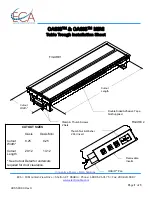
8
9. LINK/ACT indicator (green)
Flashes when data is being sent or received
over a network.
10. Control output terminal
Allows control of external equipment in
synchronization with the unit operation.
11. Functional ground terminals
If excessive noise is produced when
the speaker is connected to external
equipment, connect this terminal to the
external equipment’s functional ground
terminal, potentially minimizing the noise
level.
Note
This terminal is not for protective ground.
12. Control input terminals
Allows input of control signals from
connected external equipment to enable
actions set in the Event settings.
13. DIP switch
• LINE/MIC switch (Switch 1)
Set this switch to MIC when connecting
a microphone, and to LINE when
connecting a general sound source
device other than a microphone.
Default setting: LINE
• PAD switch (Switch 2)
Enables or disables the MIC input pad.
When the input level is high, set the PAD
to –20 dB.
Default setting: 0 dB
• PHANTOM switch (Switch 3)
Set whether or not to supply phantom
power to the microphone connected to
MIC IN. Phantom power is a 12 V DC.
Default setting: OFF
14. Reset key
The unit begins to restart when this key is
clicked.
Hold down this key until the Status indicator
(1) lights yellow to initialize the unit’s
settings.
15. Rubber feet attachment position
7. HANDLING PRECAUTIONS
• Please apply the latest firmware version to this product. The latest version is available at the TOA
DATA Library (https://www.toa-products.com/international/).
• As this product is IP-based, a slight time lag between actual and broadcast may happen.
• Broadcast audio may sometimes break up due to packet loss or network failure.
• Periodic inspection and manual rebooting are needed to extend the product life.
•
This product may reboot automatically to keep the stable operation.

































